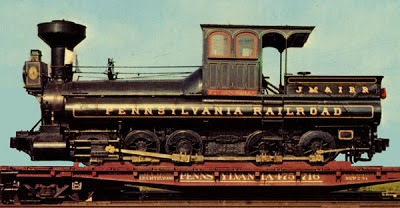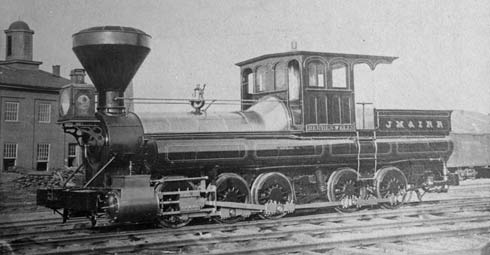Imported from: Google Blogger site
Original publish date: May 10, 2023
Purpose-built locomotive
This is a photo of the locomotive “Reuben Wells” taken as it was being hauled on a flat car to its permanent home at the Children’s Museum in Indianapolis.

The Reuben Wells was built in 1868 in the repair shops of the Jeffersonville Madison & Indianapolis Rail Road at Jeffersonville, Indiana. It was designed exclusively for a 1.3 mile stretch of track at the west end of Madison, Indiana. The section was special because it climbed out of the Ohio River Valley on a 5.89% grade. The locomotive did not need to be fast. It just needed to be able to push freight and passengers up what is reported to be the steepest non-cog railroad in the United States. (The locomotive pushed cars up the hill because the couplers were too weak for pulling.)
The 33-ft long, 0-10-0 locomotive was named for the designer/engineer, Reuben Wells. It weighed 55 tons (49,900 kg) and construction cost $18,345. The day after the locomotive arrived for service on July 17, 1868, the Madison Courier reported its weight at 70 tons. Its hard to imagine that wood and water would have accounted for the 15 ton discrepancy.
The machine apparently worked from until about 1898. It was sent to Purdue University in 1905, but appeared in exhibitions at the Chicago’s World Fair (1933-1934) and the Chicago Railroad Fair (1948-1949.) Sometime afterward, it was moved to Pennsylvania Railroad yards in Pennsylvania.
Ultimately, it was rescued from rusting away by Tom Billings, head of the Children’s Museum advisory board, and returned to Indiana in 1968. It now resides on permanent display in Indianapolis.
This image at top the Reuben Wells on a Pennsylvania Railroad flat car. The image came from a post card and I removed the distracting background so you can see the shape of the locomotive more clearly. In this photo and in photos of the current display, the Reuben Wells carries a mushroom smokestack.
Older photos are available in Madison and show a large funnel stack, indicatiing that the locomotive was burning wood at the time.
 Image courtesy of the Jefferson County Public Library. See more at the JCPL site > Local History > River to Rail.
Image courtesy of the Jefferson County Public Library. See more at the JCPL site > Local History > River to Rail.
Having walked the railroad grade many times, I find it amazing that trains were able to run year round. You can see the grade on Google Earth at:
38.749176 degrees N, 85.396786 degrees W.
You can also find more information about the machine on Wikipedia at http://en.wikipedia.org/wiki/Reuben_Wells_(locomotive).